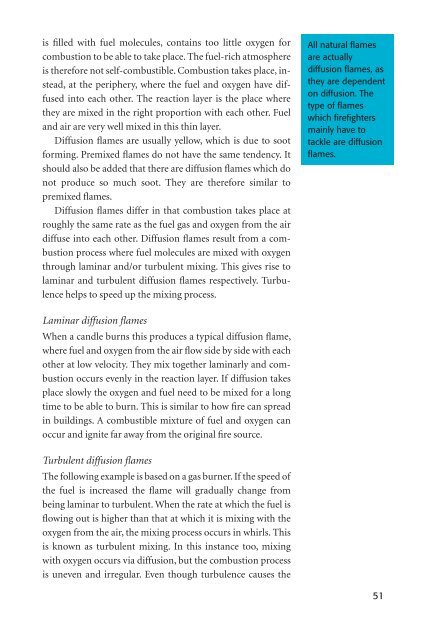Create successful ePaper yourself
Turn your PDF publications into a flip-book with our unique Google optimized e-Paper software.
is fi lled with fuel molecules, contains too little oxygen for<br />
combustion to be able to take place. The fuel-rich atmosphere<br />
is therefore not self-combustible. Combustion takes place, instead,<br />
at the periphery, where the fuel and oxygen have diffused<br />
into each other. The reaction layer is the place where<br />
they are mixed in the right proportion with each other. Fuel<br />
and air are very well mixed in this thin layer.<br />
Diffusion fl ames are usually yellow, which is due to soot<br />
forming. Premixed fl ames do not have the same tendency. It<br />
should also be added that there are diffusion fl ames which do<br />
not produce so much soot. They are therefore similar to<br />
premixed fl ames.<br />
Diffusion fl ames differ in that combustion takes place at<br />
roughly the same rate as the fuel gas and oxygen from the air<br />
diffuse into each other. Diffusion fl ames result from a combustion<br />
process where fuel molecules are mixed with oxygen<br />
through laminar and/or turbulent mixing. This gives rise to<br />
laminar and turbulent diffusion fl ames respectively. Turbulence<br />
helps to speed up the mixing process.<br />
Laminar diffusion fl ames<br />
When a candle burns this produces a typical diffusion fl ame,<br />
where fuel and oxygen from the air fl ow side by side with each<br />
other at low velocity. They mix together laminarly and combustion<br />
occurs evenly in the reaction layer. If diffusion takes<br />
place slowly the oxygen and fuel need to be mixed for a long<br />
time to be able to burn. This is similar to how fi re can spread<br />
in buildings. A combustible mixture of fuel and oxygen can<br />
occur and ignite far away from the original fi re source.<br />
Turbulent diffusion fl ames<br />
The following example is based on a gas burner. If the speed of<br />
the fuel is increased the fl ame will gradually change from<br />
being laminar to turbulent. When the rate at which the fuel is<br />
fl owing out is higher than that at which it is mixing with the<br />
oxygen from the air, the mixing process occurs in whirls. This<br />
is known as turbulent mixing. In this instance too, mixing<br />
with oxygen occurs via diffusion, but the combustion process<br />
is uneven and irregular. Even though turbulence causes the<br />
All natural fl ames<br />
are actually<br />
diffusion fl ames, as<br />
they are dependent<br />
on diffusion. The<br />
type of fl ames<br />
which fi refi ghters<br />
mainly have to<br />
tackle are diffusion<br />
fl ames.<br />
51

















